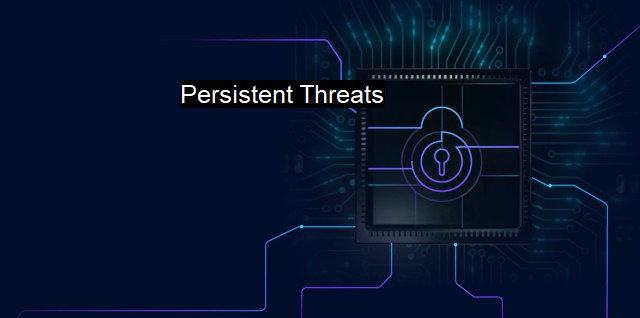What are Persistent Threats?
Navigating the Perilous Landscape of Persistent Threats: Understanding, Preventing, and Combating Sophisticated and Prolonged Cyberattacks.
Persistent Threats notably referred to as Advanced Persistent Threats (APTs), play a significant role in the field of cybersecurity and antivirus technology. In its most basic form, a persistent threat can be defined as an ongoing, continuous, and targeted cyberattack that endangers the security and integrity of data and systems on a network. They are discreet, sophisticated, and persistent in nature, often exploiting vulnerabilities over a prolonged period.Understanding the nature of persistent threats (APTs) revolves around comprehending their operational model. These threats often go unnoticed as they quietly infiltrate a system or network, avoiding detection by traditional antivirus software. APTs often exploit zero-day vulnerabilities—flaws within software that are unknown to those who should be interested in mitigating the vulnerability, including the vendor—while using stealth techniques to remain undetected.
Unlike other security threats performed by amateur cybercriminals, persistent threats (APTs) are typically state-sponsored or conducted by highly organized crime groups that have substantial resources at their disposal. These attackers demonstrate significant levels of patience, expertise, and sophistication, making APTs particularly dangerous cybersecurity threats.
Once an Advanced Persistent Threat gains entry into a system or a network, it remains inactive or gradually starts to collect data—or “learn”—about the system, as well as about the information it contains. In many cases, the main aim of a persistent threat is to gain entry and remain undetected for a substantial period. During this time, the attackers subtly extract sensitive information, subsequently wreaking havoc within the organization's IT infrastructure—a process known as data exfiltration.
An essential aspect of a persistent threat is its, well, persistence. an APT attack is a "long con." After gaining access to an internal infrastructure generally via spear phishing, water-holing, or other phishing tactics, attackers will lurk in the system until they gather all the necessary intelligence. Afterward, they begin to move around the network quietly, mapping its architecture and looking for security lapses before hitting the payload stage, which causes the most noticeable damage.
The financial implications of falling victim to an APT can be colossal. Loss of sensitive information such as client data, intellectual property, financial credentials—coupled with the potential damage to a business's reputation—can have severe consequences. Beyond the financial aspect, APTs pose a serious threat to national and international security as they can potentially target government institutions’ defense, finance, and healthcare organizations, amongst others.
In response to these threats, cybersecurity experts continually develop and adapt antivirus technologies to detect and monitor such activities effectively. Solutions like Intrusion Detection Systems (IDS), Intrusion Prevention Systems (IPS), and Security Information and Event Management (SIEM) technologies are being leveraged to identify unusual activities. Behavior analytics, threat intelligence feeds, and continuous monitoring are methods employed to detect and fend off APTs.
Yet, these solutions are just the tip of the iceberg. Truly countering APTs requires a comprehensive security strategy, one that includes consistent security awareness training for employees, regular system patches and updates, powerful encryption, and rigorous backup regimens.
Advanced Persistent Threats are a dangerous and complex cybersecurity challenge. Detecting and protecting against such persistent, intricate threats demand cybersecurity strategies which are equally proactive and resilient, extending beyond traditional antivirus protection. Whether resulting from state-sponsored attacks or organized crime groups, cybersecurity must rise to meet these continuously evolving threats.

Persistent Threats FAQs
What are persistent threats in cybersecurity?
Persistent threats are a type of cybersecurity attack that aims to infiltrate and remain undetected within an organization's network for an extended period of time. It involves using sophisticated and advanced techniques to bypass security measures and gain access to sensitive data.How do persistent threats differ from other cybersecurity threats?
Unlike other types of cyber threats, persistent threats are not just a one-time attack. They are an ongoing and continuous effort to infiltrate and maintain access to an organization's network. This makes them incredibly challenging to detect and remove, as they are designed to remain hidden for an extended period.What are some common indicators of a persistent threat?
The signs of a persistent threat can be challenging to identify, as they often operate covertly. Some indicators to look out for include unusual network behavior, slow response times, unauthorized changes to configurations or settings, and suspicious network traffic. However, it is important to note that these indicators can sometimes be attributed to other network issues, and a thorough investigation is needed to confirm the presence of a persistent threat.How can an antivirus solution help mitigate the risks of persistent threats?
Antivirus solutions play a crucial role in preventing and mitigating the risks of persistent threats. They provide real-time threat detection and response capabilities, which help identify and remove persistent threats before they can cause any damage. Additionally, antivirus solutions can help identify vulnerabilities in an organization's network and provide recommendations for mitigation, making it harder for persistent threats to gain access in the first place.| | A | | | B | | | C | | | D | | | E | | | F | | | G | | | H | | | I | | | J | | | K | | | L | | | M | |
| | N | | | O | | | P | | | Q | | | R | | | S | | | T | | | U | | | V | | | W | | | X | | | Y | | | Z | |
| | 1 | | | 2 | | | 3 | | | 4 | | | 7 | | | 8 | | |||||||